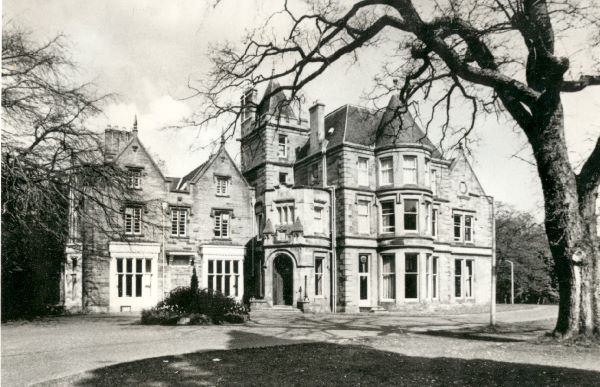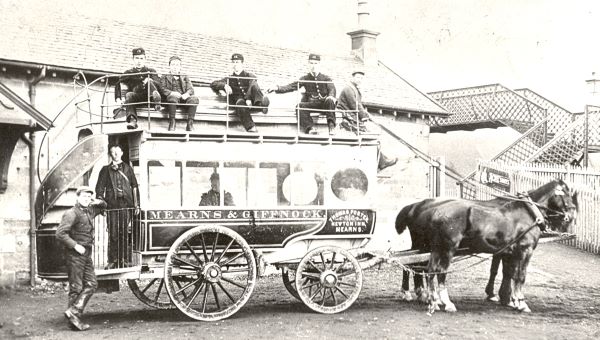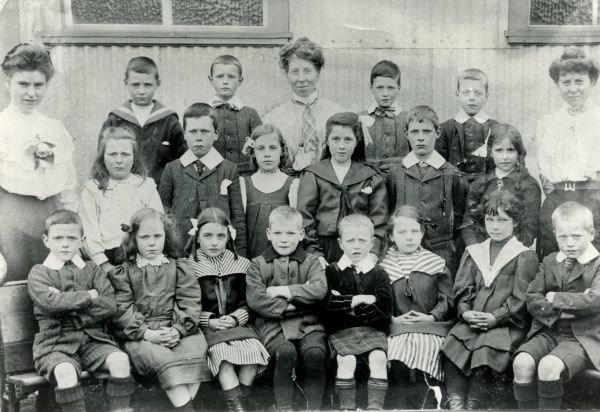

History of Giffnock
Read on to discover the origins of Giffnock
This article explores the history of Giffnock from its days as scattered agricultural community under the Barony of Eastwood, through to its industrial involvement in sandstone quarrying and mining and its emergence as a desirable residential suburb.
Early History
A few signs of early habitation have been found in the Giffnock area. There are two cup and ring marks at Deaconsbank, near the dovecot on the golf course and a large, polished stone axe, found in 1860 at Giffnock Quarries is now in the Hunterian Museum. A hoard of coins and brooches was discovered in the spring of 1879 at Giffnock. As they were sold shortly afterwards, the whereabouts of some of this has been lost. However, 466 coins were recovered by the Exchequer; they were mainly English pennies of Edwards I, II and III, but included 3 pennies of Alexander III and 8 foreign coins.
The name ‘Gisnock’ appears on Blaeu’s atlas of 1654, by which time it was owned as part of the much larger Barony of Eastwood by the Montgomery family, who were Earls of Eglinton and Lords of Eaglesham. They had a tower house as a stronghold in the barony, Corslie Castle, but its location is not clear. Suggested sites are near the old Wood Farm which is where Woodfarm Sports Hall now stands or it may have been where Crosslees House once stood, on present day Woodlands Park. (1)
Until the late 18th century Giffnock was a scattered community of ferm-touns which, during the age of agricultural improvement, were consolidated into much larger single tenanted farms. The names of the fermtouns and then the farms which followed still remain with us today. Giffnock Farm was in the area of present day Merrylee, Orchard Farm was at Giffnock station and Davieland, Bagabout, Crosslees and Brocklees all occupied the present day Rouken Glen Park. Other farm names included Henry’s Croft, Hillend, Birkenshaw, Cleugh, Slates, Braidbar and Mains.
The Eglinton connection with the barony ended in 1812 when Hugh, the 12th Earl, who was in some financial difficulty, sold the estate and it was broken up and sold in parts.
Private Estates
The sale of the barony allowed the formation of private estates in the area, most notably the present day Eastwood and Rouken Glen Parks. Eastwood House (pictured below) was possibly built as early as the 1830s and was home to several notable people. Thomas Smith and his family moved into the house in 1845. Thomas was a wealthy Glasgow merchant, and in the 1851 census, describes himself as a ‘West India Merchant’. By 1857 the family had moved into Crosslees House and rented Eastwood House to Joseph Colen Wakefield, a partner in Inglis & Wakefield who owned the nearby Busby Printworks. Joseph eventually bought the house and surrounding land but sold it in 1877 to David Tod who was a founder of Tod & MacGregor, the Glasgow shipbuilders. The last prominent owner was William Douglas Weir, later Lord and then Viscount Weir who was the founder of G & J Weir and Co, Cathcart and also minister of munitions during WW1.

Rouken Glen passed through various hands until 1858 when Walter Crum of the Thornliebank Printworks bought it as his family estate. The Crums moved into the mansion house and during their occupancy made enlargements to the house and re-designed the surrounding landscape. When Walter’s son Alexander died in 1893, the estate passed to his brother who sold it to Archibald Cameron Corbett, MP (later Lord Rowallan) In 1906, Lord Rowallan gifted the estate to the City of Glasgow and it became Rouken Glen Park. The park is currently managed by East Renfrewshire Council, who in 1984 obtained it on a 125 year lease from Glasgow.
Development of the village
When the railway reached it in 1864, Giffnock was still a rural village centred around agriculture and local industries, and remained so for quite some time afterwards.
Nearby Thornliebank was a hub of industry with the giant printworks owned by the Crum Family. In the 19th century, industry in Giffnock centred around the quarrying of minerals. Sandstone was quarried at Braidbar, New Braidbar, Orchard and Williamwood quarries and another group of quarries which stretched towards Thornliebank Station namely the Giffnock Quarry, New Giffnock Quarry, English Quarry and Flag Quarry – sometimes referred to collectively as the Burnfield quarries. Other minerals were quarried and mined in Giffnock including limestone and coal.

The railway was established primarily to service these industries. However, it also made commuting into Glasgow feasible, and it was the growth of Giffnock as a commuter suburb, from the late nineteenth century onwards, that led to the emergence of the modern residential district of today. Below you can see an image of a horse-bus outside Giffnock station. This one would connect with the trains at Giffnock, taking commuters to and from nearby Newton Mearns.
Twentieth Century
Clusters of fine houses began to be built on Orchard Drive and around Seyton Avenue as the more affluent began to take advantage of the transport links, which were supplemented in 1909 with the extension of the tramline to Giffnock.
As the village grew so too did the demand for facilities, not least local schooling. In 1902 a public school was opened in Giffnock United Free Church (now Orchardhill Parish Church) However by 1906 numbers had evidently increased and a corrugated iron building was erected in Academy Road, nicknamed the Tin Academy (image below). This was replaced by the present day sandstone building in 1912.

The building of streets and houses increased steadily but in the 1930s, a housing boom had a huge impact, with as many as 3000 homes being built and much of the agricultural land being swallowed up. During this period Mactaggart & Mickel built the Orchard Park estate and nearly 600 houses at Merrylee. The population jumped over this period and was the catalyst for more schools, public services, shops and businesses.
Giffnock even had its own cinema with the Tudor being being opened in December 1936 (on the site of present day Lidl) As well as catering for an audience of 2400, there was also a ballroom and a restaurant.
References
(1) Welsh, Thomas C., Eastwood District History and Heritage, Eastwood District Libraries, 1989, p.55
Further Reading
Sandstone to suburbia: A history of Giffnock, Eastwood District Libraries, 1988
Tobias, Michael, The Barony of Eastwood: The land and its owners after Eglinton, Postgraduate diploma in Genealogical Studies, University of Strathclyde, 2010-11
Welsh, Thomas C., Eastwood District History and Heritage, Eastwood District Libraries, 1989
